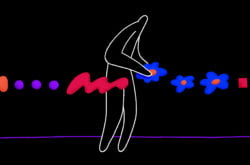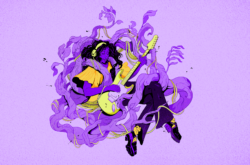Illustration: Benedikt Rugar
Your phone’s storage space is taken up by notes and voice recordings, and your hard drive is full of finished songs that never really went anywhere.
As a songwriter, you have countless ideas, but most of them never see the light of day. Why is that?
Well, unfortunately, it’s not enough to just write lyrics and melodies—someone needs to produce the music that will help turn your vision into an actual song.
This is especially true for songwriters who are (or hoping to become) artists, but it also applies to those of us who just want to make a living as a songwriter. Your songs will have a much better chance at getting picked up by other artists if you can get a demo version produced.
Now, finding a music producer whose style, creative process, and values align with yours can be challenging. Not to mention, getting them to produce song after song, not knowing whether anything will come of them, can be a huge investment in both time and money that you may not have.
That’s why being able to produce your own music as a songwriter can be such a valuable skill. You don’t need to be the next Max Martin, but having at least some understanding of how digital music production works and being able to record your ideas can have a massive impact on your music career.
In this article, we break down the core essentials for getting started with music production for songwriters, from the equipment you’ll need to the processes you’ll want to understand.
Let’s get started!
The value of understanding music production for songwriters
You can, of course, take it all the way and learn how to produce distribution-ready music completely on your own. If you’re an artist, this will potentially save you thousands of dollars. Plus, you may even be able to produce for other clients and make extra income.
But even if that’s not your goal, just learning the basics of music production will allow you to:
- Find your own unique style
- Improve your songwriting
- Produce demos to pitch to other artists
- Produce demos to show to another producer, who can then polish them up and get them ready for distribution
- Collaborate with other producers and accurately express your ideas about how you want your song to sound
Now that you’re aware of the benefits of understanding music production for songwriters, let’s get into how to actually get started. We won’t get into too much detail about specific DAWs and techniques—there are plenty of great articles about this on the Splice blog—but we’ll cover the basics steps you’ll need to take and the factors you’ll want to consider.
1. Gather equipment
Building your home studio won’t happen overnight. Some seasoned producers might tell you that you need to spend thousands of dollars on this, that, and the other, but it often takes them years to find and pay for their favorite tools.
If you’re just starting out, focus on getting the following basics. As you gainn more experience producing, you’ll be able to tell when it’s time to upgrade and expand your toolbox.
Computer
First, you’ll need a laptop or desktop computer. Look for something with a powerful processor, at least 16 GB of RAM, and plenty of storage. You’ll likely also need an external hard drive at some point, as project files and plugins tend to take up a lot of space.
DAW
A DAW (short for digital audio workstation) is the software you’ll use to produce music. Popular options include Ableton Live, Logic Pro, GarageBand, and FL Studio, though there are many others. We discuss all of these (and more) and provide links to where you can download them in this introductory guide to beat making.
Ultimately, the right choice for you will depend on the type of computer you have (Apple vs. Windows), your budget, and your personal preferences. Be sure to get trial versions of your top picks before making a final choice.
Headphones or speakers
At some point, you’ll probably want to invest in a nice pair of studio monitors, but at the beginning, you can get away with an affordable pair of headphones. Particularly if you’re not going to be doing an extensive amount of mixing and mastering (which we’ll touch on in a later section), headphones will be all you need.
MIDI controller
This isn’t a must-have—it’s entirely possible to produce music with just your keyboard and mouse. That being said, a MIDI controller will let you work faster and produce more natural-sounding music, since it captures the velocity with which you play and other small details. Especially if you already play piano, you’ll probably find that having a MIDI controller makes producing much more intuitive and enjoyable.
Audio interface
If you play other instruments such as bass or electric guitar and want to include them in your projects, you’ll need an audio interface. This is what will allow you to plug in your instruments and convert their vibrations into digital sound. The audio interface is also what you’ll use to connect your microphone to your computer.
Microphone
If you’ll be recording lead and background vocals at home, you’ll need a microphone. You could also use your voice as an instrument, or add special vocal effects to your production. There are even plugins that allow you to use your voice as a MIDI controller.
2. Learn a bit of music theory
As a songwriter, you might already have a basic understanding of music theory. Or, maybe you simply go with what “sounds good.” The latter is perfectly fine, but if you’re hoping to transition into music production, learning a bit of music theory will likely make your job a lot easier.
Knowing theory will help take the guesswork out of chords, melodies, and rhythms. It’ll also help you produce faster and better understand what makes a memorable song. Not to mention, it can actually make you more creative—it sounds counterintuitive, but understanding the ‘rules’ can help you break them better.
3. Familiarize yourself with your DAW
Once you’ve chosen a DAW, spend some time getting to know it. Look up tutorials online, take a course, or simply play around with it on your own.
You may feel a little overwhelmed at first—there are so many functions to learn, tutorials to watch, and tricks to master. But remember this: there’s no need to learn it all at once.
Simply get to a point where you know how to load up instruments, use your MIDI controller, and add effects. As you move on to the upcoming steps, you’ll naturally have more questions about how to do certain things, at which point you can dive into specific tutorials and learn new things as you go.
You can also use tools like Create in conjunction with your DAW if you want to first get started by arranging loops rather than going straight to composing with MIDI—Create automatically matches tempo and BPM, which is great for songwriters who might still be relatively new to the world of music theory.
Plugins
When you first start out, feel free to use the native plugins, virtual instruments, and effects that come with your DAW. As you spend more time producing, you may find that you want to turn to third-party tools in order to get the exact sound you’re looking for.
Sounds
If you’re looking to expand your sonic palette beyond what’s offered in your DAW, there are millions of royalty-free samples available on Splice Sounds, crafted by the world’s top producers and sound designers. If you ever feel stuck or you’re not sure how to achieve a certain sound, you’ll more than likely find what you need on Splice.
4. Try to recreate your favorite songs
Music production isn’t just about knowing your way around your DAW—a big part of it has to do with song arrangement, or knowing which instruments to layer together, when to add extra elements (and when to hold off), and how to create energy and movement within a song.
One of the best ways to learn this is by recreating existing songs. Identify songs you like, listen carefully to how they’re produced, and try to recreate them as accurately as possible.
Throughout the process, you’ll learn what you like, why it works, and how to achieve the same effect with your own music. You’ll likely also hear things that you’re not sure how to do—this is a great opportunity to look up a quick tutorial and learn something new.
5. Try to produce an original song
Once you feel like you have a good grasp on what makes a good song, it’s time to put this knowledge to the test and try producing something original. This is an exciting step, because this is where you’ll start to discover your own unique style and signature sound.
The most important thing to remember here is to have patience. The first few songs you try to produce likely won’t be any good. But every time you sit down to practice, you’ll learn something new and get a little bit better.
6. Learn mixing and mastering (optional)
The final steps in music production are mixing and mastering. Mixing is the process of adjusting all the different elements in a song to make sure they sound good together. Mastering optimizes the sound quality and ensures that the song sounds the same across different playback devices.
Some producers are well versed in mixing and mastering and are able to get their music ready for distribution on their own. If you’re keen on learning how to do it, it never hurts to expand your skillset. That being said, many others find that they’re too close to their projects to be able to objectively mix and master them, so they outsource the finishing touches to other professionals.
If your goal with music production is to be able to produce demos or collaborate with other producers, you likely don’t need to learn mixing and mastering. And if you’re hoping to produce distribution-ready songs, but you’re overwhelmed by the idea of learning a whole new discipline, it’s also perfectly fine to outsource mixing and mastering to someone else.
Conclusion: Music production for songwriters
There’s a steep learning curve when it comes to music production for songwriters (or anyone without prior experience with a DAW, for that matter). So, don’t give up when things get hard or you can’t seem to translate what you hear in your head to your workstation. There will always be something you don’t know or you haven’t tried yet, so allow yourself as much time as you need to figure it out.
As long as you stay open to feeling like a beginner, keep practicing regularly, and remember to have fun, you’ll get better and better. Soon enough, you’ll be able to take the melodies and lyrics you’ve written and turn them into actual productions all on your own.
We hope you found this guide for music production for songwriters helpful!
Explore royalty-free sounds from leading artists, producers, and sound designers:
May 24, 2022



